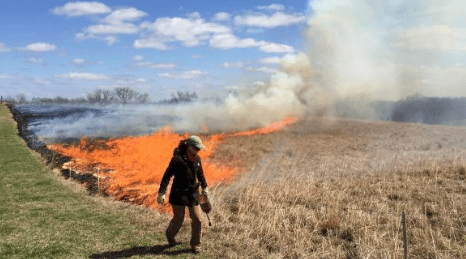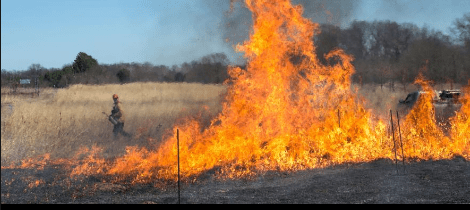Soil may burn, and at temperatures above 400 C, it can even change the texture of the soil. Gardening might benefit from burning soil, but it can also hurt your plants.

Spreading dried leaves or wood chips over the needed area and lighting them on fire can be used to burn soil. To stop the fire from spreading, the area should be divided. Weeds and undesirable pests rooted in the soil can be successfully eliminated by burning the soil.
Be prepared! Since we will go through everything you should watch out for when burning soil, both you and your garden will prosper.
Table of Contents
What Happens When you Burn Soil?
Since it has been a subject of dispute for a long time that it is possible to burn dirt, the following information has come to light:
- It is almost impossible to burn soil. By definition, burning is the process of raising the temperature in the presence of oxygen until the substance starts to react exothermically when it comes into contact with oxygen. Finely ground rocks, biological matter, minerals, and naturally occurring components make up dirt. Since the entire process is endothermic, some of the organic material may burn to some extent, although dirt is well recognized for its capacity to put out fires.
2. Since dirt is typically full of water and other minerals that we cannot burn, it is likewise non-combustible.
3. The following factors are to blame for soil’s inability to burn:
minerals like iron oxide and silica, for example (most of which are already oxides and do not burn and can burn on high temperatures)
Even though we know from the explanation above that it is difficult to burn dirt, there is a good chance it could ignite if it is dry.
How Fire Affects Soil Nutrients:
Many times, powerful fires have a highly negative impact on the physical characteristics of soil.
This could be as a result of the soil’s organic matter being consumed, as soil macronutrients are crucial for a plant’s growth.
The following nutrients in soil include:
- Nitrogen
- Phosphorous
- Potassium
- Calcium
- Magnesium
- Sulfur
By means of oxidation, ash movement, leaching, volatilization, and erosion, the fire often reduces and depletes the pool of nutrients.
According to several studies, low-intensity fires boost soil fertility because they release nutrients that were bound to dead plant tissues and the soil surface into more accessible forms.
As a result of this interdependence, soils are directly related to many other important ecosystem components like water, flowers, and animals.
The following modifications have an impact on biological properties:
population dynamics and changes in microbial species.
loss or reduction of invertebrates.
partial root removal from plants.
Additionally, because the ecosystem’s aquatic, floral, and faunal components are interrelated, all changes result from changes brought on by fire.
The quantity of heat emitted by combusting biomass and the length of time it is combusting both contribute to the impact of fire on soil.
By devouring soil organic matter, intense fires may have a negative impact on the physical characteristics of the soil.
By aggregating clay particles into stable sand-sized particles during intense fires (over 400 C), soil texture can also be permanently changed, becoming coarser and more erodible.
Physical effects of fire on soil include disruption of the soil’s structure, decreased capacity for retaining moisture, and the creation of water repellence, all of which enhance erosion susceptibility.
Hydrophobic or water-repellent soil conditions can develop when fire burns vegetation and underlying litter layers.
How to Burn Soil?
The straightforward response is challenging, but soil can burn if temperatures rise above 280°C due to exothermic processes (those reactions that produce heat).
If oxygen is not kept away from the char surface when the soil’s surface temperature exceeds 500 to 600C, brilliant combustion will take place.
The presence of organic matter and the burning of soil
Some soils with near-zero organic matter may not burn at all but may smolder somewhat if heated to four or five degrees Fahrenheit or greater. Soils can contain as little as zero organic matter or as much as 50% organic matter or more.
If heated to roughly the same temperature if the soil is dry, soils with a lot of organic content, as the top layer in some forests, swampy ground, or grasslands, will burn.
Lower temperatures may still result in ignition, but this is unlikely.
To burn garden soil:
- Cover the area that will be burned with mulch, wood chips, or even dry leaves.
- Avoid adding anything to the soil that can seep into the soil and harm plants that will be seeded later, such as gasoline.
- Important Reminder: Leave a clear perimeter around the location to prevent unintended fire spread to nearby regions.
- Watch the fire as it burns by lighting it from various angles.
In general, it takes a while for damp soil to heat up, thus unless the soil is extremely dry, a fire often only burns relatively little of the organic stuff directly on top.
Given that little air can reach the organic content in the soil in this situation, the soil typically smolders, which means it is burning but only very slowly. It cannot, therefore, burn quickly.
To learn more, read our article on mulched sand fires.
Can Burning Soil Prevent Weeds?

Did you know that some robbers live beneath the ground? They rob our food crops of their nutrition, sunlight, and water. They are weeds, plain and simple. Therefore, how can one stop these thieves?
Although there are many strategies to get rid of weeds, burning soil is one of them that relates to our subject.
Weeds and seeds that have been retained on the soil’s surface can both be killed by burning the soil.
It is exceedingly challenging to kill them after they are submerged beneath the soil’s surface.
The explanation is that dirt protects seeds by acting as an incubator. Each weed species must therefore be aware of the temperature, duration of exposure, and other factors.
Overall, one of the best methods for getting rid of weeds from garden soil may be flame weeding.
Its advantages as an organic process are twofold: as it eliminates weeds and promotes the growth of crops or other plants, it naturally replenishes the nutrients in the soil.
Burning Soil to Get Rid of Pests
By exposing them to high temperatures, burning the soil will assist in both avoiding pests and getting rid of their eggs from the soil.
This can be accomplished either by burning the dead leaves in the manner described above or by using an acetylene torch.
Although it can be difficult, using an acetylene torch provides you with more control over burning.
Note: Burning soil can be extremely harmful to beneficial microorganisms like earthworms and nematodes in the soil, despite the fact that it is good in getting rid of weeds and unpleasant pests.
After burning, the soil needs to be left alone for a while so that a healthy microbial community may be rebuilt. To hasten the process, beneficial nematodes and earthworms can also be added.
When is the Best Time to Burn soil?
Now that we’ve covered the effects, advice, and advantages of burning soil, it’s time to determine when burning land or soil is acceptable.
There are probably only a few seasons that are thought to be best for burning land because it depends on the use, habitat, and topography of the area.
On dry days, garden soil should be burned or exposed to flames in the late evening. This guarantees that the moisture levels are low enough for the flame’s heat to have the greatest impact on the weeds and pests being targeted,
And last, it’s thought that burning is most effective in the late winter or early spring. New plant growth hasn’t yet emerged, and any existing plant growth is dormant or dead at this period.
Takeaway:
In this article, we address the most intriguing concerns surrounding soil burning and learn that it is possible to burn soil at very high temperatures while keeping in mind that doing so can have a number of negative effects on the ecosystem as a whole because it results in the loss of extremely important nutrients like nitrogen, potassium, and phosphorus that are essential for plant growth.
Burning soil has many advantages, including boosting soil fertility and destroying plants that steal essential soil elements.
When considering burning the soil, one should also look at the specifics of the temperature and time of year.
Additionally, it is impossible to burn dirt since it contains substances like silica and iron oxides, as well as living things and decomposed plants. On the other hand, dirt can burn at extremely high temperatures.
FAQ
Can dirt be flammable?
Yes, it is made of organic components that easily catch fire in dry conditions, such as peat moss and wood chips. Potting-soil fires are a serious risk that many people are ignorant of, whether they occur in Old Town or on a person’s patio in their backyard.
What happens when you burn the ground?
The destruction of soil structure, decreased ability for retaining moisture, and the emergence of water repellency are all physical effects of fire on soil, and they all enhance erosion susceptibility.
Can dirt spontaneously combust?
It will spontaneously ignite if you let it dry out and it reaches a specific low moisture content, according to Captain Joe Mullens of Rockingham County Fire and Rescue.
What materials can spontaneously combust?
In the correct circumstances, rags and towels covered in oils, especially cooking oils, hot laundry piled up, sizable quantities of compost, mulch, manure, and leaves, and moist baled hay can spontaneously ignite.
